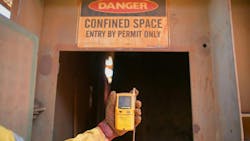If tasked to serve as a confined entry attendant, do you know what your duties are? A common misperception is that it’s your job to wait around until someone says you are needed to go get tools/materials or just to wait as a standby rescue person who can rush in and get an incapacitated crew member back out to safety.
At a refinery in western Louisiana, an attendant noticed his counterpart in the vessel had been quiet a long time, so he poked his head into the vessel to check on the man. Because the vessel had been nitrogen-purged, the attendant passed out and fell in. A passing operator noticed a confined entry permit but nobody working. He radioed to the shift supervisor that neither person on the permit seemed to be around. Then he looked into the vessel and saw two men lying still. He went inside to haul them out, and he also succumbed. Getting no radio reply, the shift supervisor sent a properly equipped rescue team, each of which was wearing the air packs required for being in that vessel. Did the attendant do his job? No.
The main job of the attendant is to serve as the link between the outside world and the crew inside the confined space. If you keep this in mind, you will understand why the attendant does not enter the confined space. Breaking that rule can be fatal to the attendant — and then there’s nobody left to call for help. That said, an attendant can enter the confined space if both of these conditions are met:
- The attendant has confirmed that help is less than a minute away or there is another attendant already on duty at the entrance to that confined space.
- The attendant has taken precautions to ensure he doesn’t just become one more person to rescue (has the correct PPE and is observing all of the requirements on the confined entry permit).
Here are some other requirements that exist because the attendant is the link between the outside world and the crew inside the confined space:
- The attendant never leaves the area without securing a replacement attendant. If a replacement cannot be found, the attendant stays there regardless of any other demands.
- The crew is in the vessel because the attendant gives them permission to be there.
- If the attendant absolutely must leave, then the crew must exit the vessel. No attendant means no being in the vessel.
- The attendant does not go fetch tools or anything else. The attendant (who is the link to the outside world) radios for what’s needed to be brought to the confined space area. The only way this restriction is lifted is if the crew exits the vessel.
Waiting around outside the vessel can be boring, but it is not acceptable to nap, read a novel, check text messages, chat with someone else (via radio or in person), or do anything else that may prevent the attendant from hearing the crew (or hearing them suddenly go silent, something that will occur if they pass out from low oxygen). The attendant can break the boredom by checking in with the crew with questions, such as, “How are you doing in there? What’s your O2 reading? What is your temperature?” The attendant can also check the ventilation (if being used). For example, is the fan still running and pointed into the vessel?
If the confined entry permit allows only X minutes of being in the confined entry area, each person who entered will have logged in his or her entry time. The attendant needs to keep tabs on that and call for people to exit when their time is up.
Do you know how to properly relieve an attendant? When you arrive, ask for a briefing on what the crew is doing and how long they’ve been in there. Ask about the extraction process and which (if any) extraction gear is being used. Before letting the other attendant leave, review with that person the Confined Entry Permit and ensure you understand it. This works in reverse, if you are being relieved then ensure your relief person understands the Confined Entry Permit before leaving. If there’s a problem you can’t resolve, radio to your supervisor.
About the Author

Mark Lamendola
Mark is an expert in maintenance management, having racked up an impressive track record during his time working in the field. He also has extensive knowledge of, and practical expertise with, the National Electrical Code (NEC). Through his consulting business, he provides articles and training materials on electrical topics, specializing in making difficult subjects easy to understand and focusing on the practical aspects of electrical work.
Prior to starting his own business, Mark served as the Technical Editor on EC&M for six years, worked three years in nuclear maintenance, six years as a contract project engineer/project manager, three years as a systems engineer, and three years in plant maintenance management.
Mark earned an AAS degree from Rock Valley College, a BSEET from Columbia Pacific University, and an MBA from Lake Erie College. He’s also completed several related certifications over the years and even was formerly licensed as a Master Electrician. He is a Senior Member of the IEEE and past Chairman of the Kansas City Chapters of both the IEEE and the IEEE Computer Society. Mark also served as the program director for, a board member of, and webmaster of, the Midwest Chapter of the 7x24 Exchange. He has also held memberships with the following organizations: NETA, NFPA, International Association of Webmasters, and Institute of Certified Professional Managers.
